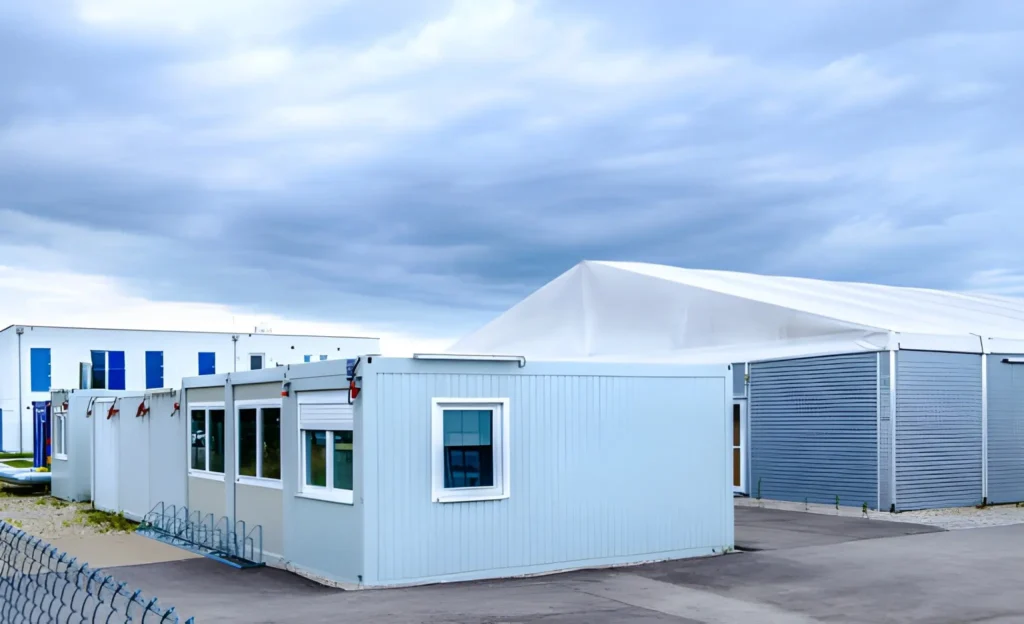Office space costs have gotten ridiculous. Leasing commercial property in decent areas can run $20 to $50 per square foot annually, and that’s before utilities, maintenance, or the furniture you’ll need. Small businesses and growing companies face a tough choice—commit to expensive long-term leases or make do with inadequate space. Thankfully, portable office buildings for sale offer a third option that doesn’t drain your budget while still giving you legitimate workspace. These aren’t the cramped, poorly-lit boxes you might imagine. Modern portable offices come with features that rival traditional buildings at a fraction of the cost, and you actually own the asset instead of throwing money at a landlord month after month.
Breaking Down the Affordability Factor
Let’s talk real numbers. A basic 8×20 portable office (160 square feet) starts around $12,000 to $18,000 depending on features and your location. A mid-size 12×40 unit with better finishes and full climate control runs $25,000 to $45,000. Compare that to constructing a permanent 480 square foot building which easily hits $150,000 or more once you factor in foundation, permits, contractor fees, and the months of construction time.
The purchase price is just the starting point though. Delivery and installation add costs—usually $1,500 to $4,000 based on distance and site complexity. You’ll need basic site preparation which might be as simple as a gravel pad or as involved as concrete piers, running another $1,000 to $3,000 typically. Still, even with these extras, you’re looking at total costs that make sense for businesses that can’t justify or don’t want permanent construction.
Financing options exist through equipment lenders and some manufacturers offer in-house financing. Interest rates vary but often run 6% to 10% for qualified buyers. Monthly payments on a $35,000 unit over five years at 8% work out to roughly $710, which compares favorably to leasing similar square footage in most markets.
Modern Features That Don’t Break the Bank
Today’s affordable portable offices include features that were premium options just a few years ago. LED lighting comes standard in most units now because it saves energy and manufacturers would rather wire it correctly from the start. Basic electrical packages provide 100-amp service with multiple outlets, enough for typical office equipment. Upgraded packages push to 200-amp if you need more capacity.
Climate control varies by price point. Entry-level units might include just a wall-mounted AC unit and space heater, which honestly works fine in moderate climates. Mid-range models incorporate HVAC systems with ductwork and thermostats for better temperature distribution. The newer mini-split systems are gaining popularity because they’re efficient and don’t require extensive ductwork.
Insulation quality directly impacts utility costs and comfort. Budget units use standard fiberglass batting with R-11 to R-13 values. Stepping up gets you spray foam insulation achieving R-19 or better, which makes a noticeable difference in extreme temperatures. Windows should be double-pane regardless of price point—single-pane windows in a workspace are miserable and inefficient.
Choosing the Right Size Without Overspending
Size selection affects both upfront cost and long-term usability. A common mistake is buying too small to save money, then realizing you can’t actually work comfortably. Figure at least 75 to 100 square feet per workstation if people will spend full days there. A 12×32 unit (384 sq ft) realistically holds three to four people working simultaneously without feeling cramped.
Smaller units like 8×16 or 8×20 work for single-person operations—think site supervisors, security checkpoints, or sales offices where only one person occupies the space regularly. These cost less to buy and transport but feel confining if you’re there eight hours daily.
Larger configurations of 12×60 or even bigger offer more flexibility but cost increases aren’t linear. A 12×60 unit doesn’t cost three times as much as a 12×20, but you will pay significantly more for delivery and potentially need more complex site preparation. Balance current needs against probable future expansion rather than just buying the cheapest option that barely fits today’s requirements.
Where Savings Opportunities Hide
Used and refurbished portable offices sell for 40% to 60% less than new units. If you can find one in decent shape, this option makes financial sense. Check floor integrity carefully, inspect the roof for leaks, and test all electrical and HVAC systems. Cosmetic issues like worn flooring or dated paint are easy fixes compared to structural or mechanical problems.
Direct-from-manufacturer purchases typically beat dealer pricing. Manufacturers have overhead and profit margins too, but cutting out the middleman saves something. However, dealers sometimes offer better financing terms or package deals that offset higher prices.
Basic configurations save money over fully-customized builds. Standard door and window placement, stock interior finishes, and pre-set electrical layouts cost less because manufacturers build them in quantity. Custom requests like extra windows, special flooring, or modified layouts add charges quickly.
Maintenance Costs People Forget
Portable offices need less maintenance than traditional buildings but aren’t maintenance-free. Budget for annual roof inspections and occasional sealing, especially at seams and around penetrations. HVAC systems require filter changes and seasonal service. Skirting around the base blocks wind and pests but needs periodic checking for damage.
Exterior painting or siding maintenance depends on materials chosen. Metal siding lasts decades with minimal care while vinyl can crack in extreme cold. Wood-look finishes need more attention than basic painted surfaces. Factor these ongoing costs into affordability calculations—the cheapest purchase price doesn’t mean lowest total cost of ownership.
Interior updates happen too. Carpet or flooring wears out over time. Paint refreshes every few years keep things professional-looking. These aren’t huge expenses but they’re real costs that affect the true affordability over the building’s useful life.
Also Read-Why Fashion Enthusiasts Swear by Corteiz



